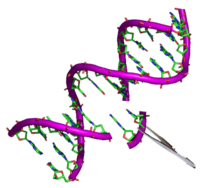
Photo from wikipedia
Abstract Breeding soundness examinations for bulls rely heavily on the subjective, visual assessment of sperm motility and morphology. Although these criteria have the potential to identify infertile males, they cannot… Click to show full abstract
Abstract Breeding soundness examinations for bulls rely heavily on the subjective, visual assessment of sperm motility and morphology. Although these criteria have the potential to identify infertile males, they cannot be used to guarantee fertility or provide information about varying degrees of bull fertility. Male factor fertility is complex, and the success of the male gamete is not necessarily realized until well after the spermatozoon enters the oocyte. This paper reviews our existing knowledge of the bull's contribution from a standpoint of the sperm's cargo and the impact that this can have on fertilization and the development of the embryo. There has been a plethora of recent research characterizing the many molecular attributes that can affect the functional competence of a spermatozoon. A better understanding of the molecular factors influencing fertilization and embryo development in cattle will lead to the identification of biomarkers for the selection of bulls of superior fertility, which will have major implications for livestock production. To see this improvement in reproductive performance, we believe incorporation of modern technology into breeding soundness examinations will be necessary—although many of the discussed technologies are not ready for large-scale field application. Each of the ‘omics fields discussed in this review have shown promise for the identification of biomarkers of fertility, with certain families of biomarkers appearing to be better suited to different evaluations throughout a bull’s lifetime. Further research is needed for the proposed biomarkers to be of diagnostic or predictive value. Summary Sentence A review of proteins, transcripts, and metabolites identified in spermatozoa and seminal plasma, with a focus on molecular factors correlated with high or low fertility bulls to evaluate if they could be used as predictive biomarkers in the future.
Journal Title: Biology of Reproduction
Year Published: 2022
Link to full text (if available)
Share on Social Media: Sign Up to like & get
recommendations!